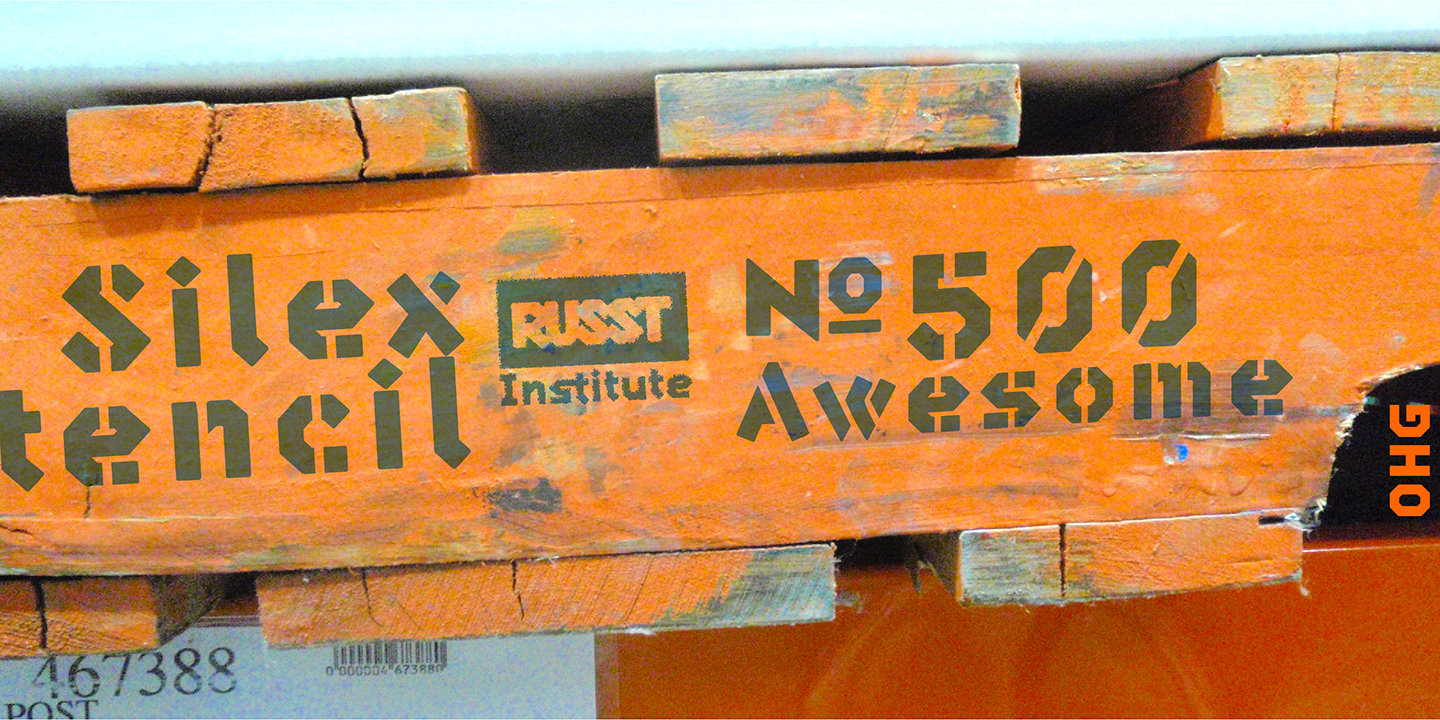Industrial typefaces

Comments
-
Multipurpose workhorses that do their job without fanfare? Franklin Gothic, Charter, Akzidenz Grotesk, Clarendon (mostly).2
-
I think of something simple and built out of reusable shapes. Something that looks like it was designed by an engineer or draughtsman far removed from the world of Zapfino. My Ironstrike family was based on a ghost sign painted on the wall of a gym that used to be a warehouse. The gym was frequented by muscleheads who could handled dumbells that weigh as much as me. I kept that feeling in mind while designing Ironstrike. Tal Leming’s United is another typeface I consider industrial.
5 -
I’ll be the lazy one who mentions Neville Brody’s Industria. :-)
I tend to think of things with lots of square or bevelled edges. Luis Siquot’s Abaton is another example that comes to mind.
0 -
I think of typefaces that originated mostly in the second phase of the Industrial Revolution (1870-1914), whose character reveal a spiritual attunement with that time.
I.e. I consider many late XIX century grotesques/linear typefaces as industrial, but also typefaces like De Vinne, Century.
I exclude typefaces of the era whose form is more anchored to tradition or pays direct debt to classic and previous centuries letterforms, such as Souvenir or ATF Bodoni, many continental ones inspired by Art Nouveau and Jugendstil.1 -
Most of which, not incidentally, originated during the second Industrial Revolution.Stephen Coles said:Multipurpose workhorses that do their job without fanfare? Franklin Gothic, Charter, Akzidenz Grotesk, Clarendon (mostly). 1
1 -
DIN.
4 -
We could call DIN “modern industrial” — but more invested with a "normative” need, an idea of function brought forth and reinforced by the modernist vocation, such as OCR or signage typefaces.Florian Hardwig said:DIN.1 -
Ironstrike reminds me of Clicker, albeit less modular.James Puckett said:I think of something simple and built out of reusable shapes. Something that looks like it was designed by an engineer or draughtsman far removed from the world of Zapfino. My Ironstrike family was based on a ghost sign painted on the wall of a gym that used to be a warehouse. The gym was frequented by muscleheads who could handled dumbells that weigh as much as me. I kept that feeling in mind while designing Ironstrike. Tal Leming’s United is another typeface I consider industrial.0 -

7 -
Maybe it is because I grew up in Pittsburgh, an industrial city, I think of type that reminds me of what I saw on heavy industry locations. Rugged, sturdy, heavy duty.

4 -
0
-
While folks are definitely describing the overall mood of industrial typefaces very well, I’d also like to add that the aesthetic is a product of practicality. They have to be easy to reproduce (straight lines, few or no curves, simple forms) and easy to apply on a large scale (stencils, stamps). Of course these days, any letter can be printed on anything without too much effort, but those were the material requirements a 100-150 years ago at least.4
-
Bank Gothic
and all those “college” fonts1 -
Then there’s industrial metal as a music genre, so maybe anything that goes with that?
 0
0 -
I thought of that analogy too, but "industrial" music is really a post-industrial phenomenon and its medium of sublime dissonance and noise is really almost opposite the stresses on function, efficiency, and simplification that I associate with "industrial" types.2
-
Thanks, everyone. Now I know that there’s a range of ideas about industrial type. Here's what I have in mind when I use the term industrial: square with round or diagonal chamfers, somewhat modular. Angular railroad signage. Sports jersey octagonal type. Grid based railroad lettering. Signage in the “stovepipe” category is industrial. The current trend of “ironworks” display type is industrial. There’s also industrial display type that was fashionable in the 1940's/1950’s that's on the edge of Art Deco with aligned high or low crossbars. Sometimes the line between Art Deco and industrial can be fuzzy. While industrial type is easy to reproduce with a straight-edge and compass, it’s designed to be decorative. Chank Diesel's Parkway is an example of industrial script.
I classify DIN as technical. Technical typefaces look like they were designed by engineers rather than type designers. They have curves and aren’t intended to be decorative (but we might use them that way). Technical typefaces may not be the most readable, but the intention is legibility and usually the ability to reproduce them with straight edge and compass. Examples: some license plate type, Highway Gothic, OCR, chainprinter/typewriter* DYMO labels, architect templates and stencils. Not all stencils are technical typefaces, but I think the majority of twentieth century stencils are. They’re often weren’t intended to be decorative; just functional and as legible as possible.
Techno is harder to define as it can be like industrial and there’s some crossover. Techno has ultramodern aspects and eschews classical elements. I consider Microgramma to be the first techno typeface. There’s some overlap in 1970's/early 1980's Japanese industrial logotypes like Namco (check my Uniwars interpretation of that style). Industria is both techno and industrial—right on the border. Bank Gothic isn't techno...the old-fashioned elements put it in the industrial category.
That’s how I define industrial and it was interesting to see the different ideas people had—not as clearly defined as I’d anticipated.
* I don’t classify most typewriter type as technical. I’m picturing sans-serif IBM chainprinter type of the 1960’s-1980’s. The type of thing you’d see on an old driver's license or magazine subscription label.
5 -
This discussion seems to leave out the serif fonts that might have a right to be called 'industrial.' When I think of 'industrials serifs,' I tend to go back to mid-19th century, early-Victorian industry. To my mind, Bookman and Benjamin Fox's first Clarendons are quintessentially 'industrial' faces.2
-
Good point, Konrad. New York City has those old industrial slab serifs all over the place on nineteenth century buildings.
 1
1 -
Thank you. Quintessentially American-industrial is the I-beam -- the steel pylon shaped like a slab-serif, uppercase /I/, to withstand stresses from all sides. That steel beam, and the stolen labor of black men and poor immigrants, built the East Coast. The I-beam was everywhere.

3 -
For me industrial type is when it is engraved on metal objects, like vintage film cameras a few quick photos I just took from a some I have here https://drive.google.com/drive/folders/1gT2XYnqD2lF8ZjS39K9XInMTLWlc8Ha7?usp=sharing)I find they are usually sans, have mostly straight lines (but are not strict about it), and the terminals are rounded or have soft corners. I believe this is due to the tool bits used in the etching.3
-
@Eris Alar
I'd classify that as technical.4 -
I think "industrial" has always been ambiguous, when we use it in regard to fonts. Now that I think about it, it seems we've let it denote two different things. 1) fonts that required some industrial gear to make. E.g., an acetylene torch to cut out of a steel plate; or a drop force to stamp into a metal sheet. The "college squarish" kind of type; or the Constructivist style (in Russia)/New Deal era (in America) all-cap fonts used in steel mills, WPA posters, early Soviet propaganda, etc. The kind that Drone Ranger, the font developed for the Women's March organization, pays tribute to:

2. Fonts associated with the Industrial Age, i.e. the part of the century when Western economies relied on heavy manufacturing, before they switched to service industries. Primarily, that denotes early slab serifs, and the impersonal, generic faces used for signage in industrial facilities at that time.
No?3 -
I've worked in a (pre-robotic) automobile engine assembly plant, a steel fabrication plant, where I cut and bent steel for the conveyors used in factories and mining (miles long sometimes), and as a welder, making balance beams for truck and train scales. The word industrial to me has a very material and visceral meaning. It conjures up the power, hard work, skill, pride and ultimately, the messiness of making things. I see the flawless welds, free from splatter and heat distortion — and the ones that needed to be ground and hammered flat, work tables covered in welding spatter and slag, the sharp, ragged edges of acetylene torch-cut steel, showers of sparks and clouds of greasy smoke from someone welding cold-rolled steel. Not pleasant, but exciting and challenging. Never boring. Grime everywhere.
I imagine type as kind of like the nuts-and-bolts of communications: Endless tiny little bits and pieces, essential to the makeup of a giant system... Tiny bits and pieces someone needs to design and construct or otherwise tinker with, but which nobody else needs to think, or even know much about. Thinking of type and of my time in those jobs, industrial imagery is at that micro scale and seen from the inside: As a welder, it would be my workstations and the tools I worked with. Heavy steel work tables, assembly jigs, steel parts baskets and pallets, all battered and worn smooth or ragged from years of rough use... hammers, files, cold chisels, clamps and so on. There's always lots of dust from grinders, welding slag and spatter... And just plain old rust. Amidst all the pale grey-green walls and structural steel of the building there are plenty of bright colours... Things that could hurt you were colourful. Mostly "safety orange" or bright yellow or red or yellow and black. Nothing looked new for long. Industrial spaces are large, so there is atmospheric perspective. Details fade with distance. Sunlight shines in and down through clearstory windows, lighting up the dust and smoke.
A different kind of beauty.
Translated into a typeface: It is conceived by engineers, drawn by draftsmen, executed by people who make fine adjustments with ball peen hammers.
The sample below, Silex Black Stencil was the third typeface I made, but I think it sort of sums up how I see "industrial" in the form of a typeface. 7
7 -
It's in the name, isn't itFlorian Hardwig said:DIN. 0
0 -
i like it
0 -
1
Categories
- All Categories
- 46 Introductions
- 3.9K Typeface Design
- 487 Type Design Critiques
- 564 Type Design Software
- 1.1K Type Design Technique & Theory
- 656 Type Business
- 861 Font Technology
- 29 Punchcutting
- 521 Typography
- 119 Type Education
- 325 Type History
- 77 Type Resources
- 112 Lettering and Calligraphy
- 33 Lettering Critiques
- 79 Lettering Technique & Theory
- 559 Announcements
- 94 Events
- 114 Job Postings
- 170 Type Releases
- 180 Miscellaneous News
- 276 About TypeDrawers
- 54 TypeDrawers Announcements
- 120 Suggestions and Bug Reports











